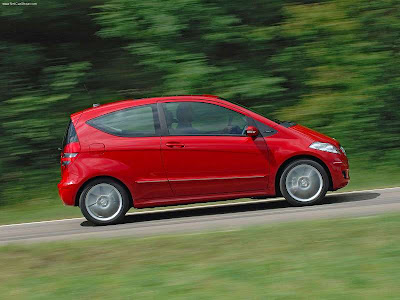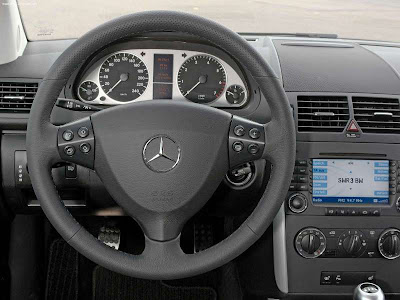




Mercedes-Benz A-Class W169
The second generation A-Class, the W169, was officially presented at Mercedes' Stuttgart factory on June 28, 2004 with availability in early September.
Driving assistance
The car is designed according to Mercedes-Benz concept of 'Touch And Feel' (TAF).
The multi-function steering wheel places controls for the radio, telephone, and other systems conveniently within reach of the thumbs of the driver. Power steering (standard feature) aids control of the automobile, with its behaviour varying according to the vehicle's speed.
The Mercedes COMAND APS is a navigation system which provides directions via SMS. The radio unit also provides DVD and telephone functionality, with various versions available (standard Audio 20 radio/single CD, Audio 50 APS or COMAND APS).
The Parktronic system provides audio and visual signals to indicate how far the car is from an obstacle.
The A-class optionally includes a "Light & Sight" package which includes bi-xenon HID headlamps with gas-discharge bulbs; cornering lights (main-beam headlamps at road junctions and tight corners); "Headlamp Assist, which automatically turns on the lights when needed; and a rain sensor that adjusts wiper speed depending on rainfall intensity.
As a standard feature, when entering a tunnel or an underground garage the car goes into "tunnel mode", where all windows and the panoramic sliding sunroof are closed.
Temperature control
The standard temperature control system has separate temperature settings for driver and front passenger sides, and includes a "Heater Booster System" that can flood the interior of the car with hot air.
The optional Themotronic system maintains and regulates the temperature in accordance with a set of sensors that measure temperature, sunlight, humidity and pollutant levels in the ambient air.
Safety
Triggered by the "moose test" failure, a number of improvements were made in the W169 model.
The car is constructed with high-strength steel alloys with bonded joints. It has a large number of airbags including optional rear side airbags (for side-impacts in the backseats), optional side-curtain airbags, and standard head and thorax-protection side airbags. The front airbags are adaptive with two-stage gas generators operating according to the severity of accident.
The force exerted by the seat belt system during a collision adapts dynamically depending upon the collision characteristics. The 'active' head restraints (standard for driver and front passenger) give enhanced protection from neck injury, especially during rear collisions.
Passenger and cargo space
The cargo capacity of the W169 was increased by 15 percent compared with the W168. The seats can be moved and configured in various ways:
+ EASY-ENTRY: Front seats slides forwards with the backrest folded forwards to afford the rear seat passengers more room for getting in and out. (standard on three-door)
+ EASY-VARIO: Both rear-seat cushion sections are folded forward, while the luggage compartment floor can be set to one of two different heights. (optional for three-door)
+ EASY-VARIO-PLUS: Both rear-seat cushion and the front passenger seat are folded forward. Increases load capacity to as much as 1995 litres. (optional for five-door)
Engine and drive system
Seven types of motors are available: four petrol (gasoline) (A150, A170, A200, A200Turbo) and three diesel (160CDI, 180CDI, 200CDI), all being four-cylinder and having either 5 or 6 gears. A continuously variable transmission system called "Autotronic Constantly Variable Transmission" (CVT) is an optional feature.
The petrol A200 Turbo provides 193 hp and 280 Nm of torque (rotational force); the diesel A200 CDI has 140 hp and 300 Nm.
It is estimated that the W169 engines provide a 40% increase in power and a 10% decrease in fuel consumption compared to W168 engines.
The most powerful model can take the car from a standstill to 100 km/h in 8.0 seconds, and has a top speed of 227 km/h.
The newly developed direct-injection CDI diesel units use a common-rail direct injection system that improves fuel consumption and reduces exhaust emissions and noise levels.
All the engines meet the tight EU4 emissions limits. A particulate filter system is available as an option for the diesel units which reduces the particulate emissions by about 99% without the need for additives.
The A-Class is a front wheel drive car and features traction control (ASR) as standard, as well as electronic stability control and anti-lock brakes (ABS).
Handling is improved by precision tracking and anti-roll support, and by a Parabolic Rear Axle.
A "Selective Damping System", in which the shock absorber forces respond differently according to conditions, is standard. For example, under normal conditions it operates at soft absorption; while cornering at speed it changes to full damping force.
The W169 optionally comes with light-alloy wheels, with a run-flat feature, Tirefit tire sealant and a tire-pressure-loss warning device.
Tire sizes are:
+ 185/65 R 15 with wheel trim (classic model)
+ 185/65 R 15 light-alloy wheels (elegance model)
+ 195/55 R 16 light-alloy wheels (avantgarde model)
Production
Sales of the W169 were targeted at 50,000 units in 2004. Dr. Joachim Schmidt, Executive Vice President Sales and Marketing, Mercedes Car Group, said that target had been reached even before vehicles arrived in dealer showrooms.
DaimlerChrysler invested EUR 900 million in developing the Rastatt plant where the A-Class is produced, and created 1600 new jobs (for a total of 4700). A further 600 people work on the industrial estate at the plant site.
In 1999, Mercedes Benz opened, in Mine Gerais (Brazil), its first factory in South America dedicated to passenger cars, with an investment of USD 840 million and 10,000 employees. The factory initially produced A-Class and C-Class models, assembling them from pieces manufactured in Germany. The target for the cars was regional markets (from Argentina to Mexico) with modifications made to the cars to suit local conditions, like a protection for the motor base for the mostly poor roads in South America. In 2005 the factory stopped production of A-Class cars.
No comments:
Post a Comment